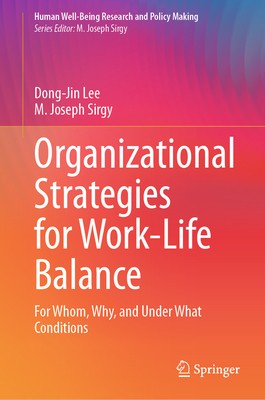
- We will send in 10–14 business days.
- Author: M Joseph Sirgy
- Publisher: Springer
- ISBN-10: 3031563131
- ISBN-13: 9783031563133
- Format: 15.6 x 23.4 x 1.4 cm, hardcover
- Language: English
- SAVE -10% with code: EXTRA
Reviews
Description
This book provides a systematic review of the research literature related to the effectiveness of organizational policies and programs on work-life balance (WLB). It discusses policies and practices related to workload management, flextime, flexplace, alternative job arrangements, and family care. Based on the evidence, the authors make specific recommendations to organizational executives and HR directors to design and implement work-life balance policies and programs to maximize their effectiveness and help employees achieve their optimal level of work-life balance. Specifically, the authors discuss how to: (1) identify employees with greater need for WLB programs, (2) evaluate environmental circumstances for WLB programs (3) design effective WLB policies and programs, (3) facilitate effective implementation of WLB policies and programs, (4) provide management support for WLB policies and programs, and (5) evaluate performance of WLB policies and programs. Written lucidly by experts in the field and with many case studies and examples, this book appeals to a wide range of academic and professional readers.
EXTRA 10 % discount with code: EXTRA
The promotion ends in 20d.09:23:09
The discount code is valid when purchasing from 10 €. Discounts do not stack.
- Author: M Joseph Sirgy
- Publisher: Springer
- ISBN-10: 3031563131
- ISBN-13: 9783031563133
- Format: 15.6 x 23.4 x 1.4 cm, hardcover
- Language: English English
This book provides a systematic review of the research literature related to the effectiveness of organizational policies and programs on work-life balance (WLB). It discusses policies and practices related to workload management, flextime, flexplace, alternative job arrangements, and family care. Based on the evidence, the authors make specific recommendations to organizational executives and HR directors to design and implement work-life balance policies and programs to maximize their effectiveness and help employees achieve their optimal level of work-life balance. Specifically, the authors discuss how to: (1) identify employees with greater need for WLB programs, (2) evaluate environmental circumstances for WLB programs (3) design effective WLB policies and programs, (3) facilitate effective implementation of WLB policies and programs, (4) provide management support for WLB policies and programs, and (5) evaluate performance of WLB policies and programs. Written lucidly by experts in the field and with many case studies and examples, this book appeals to a wide range of academic and professional readers.


Reviews